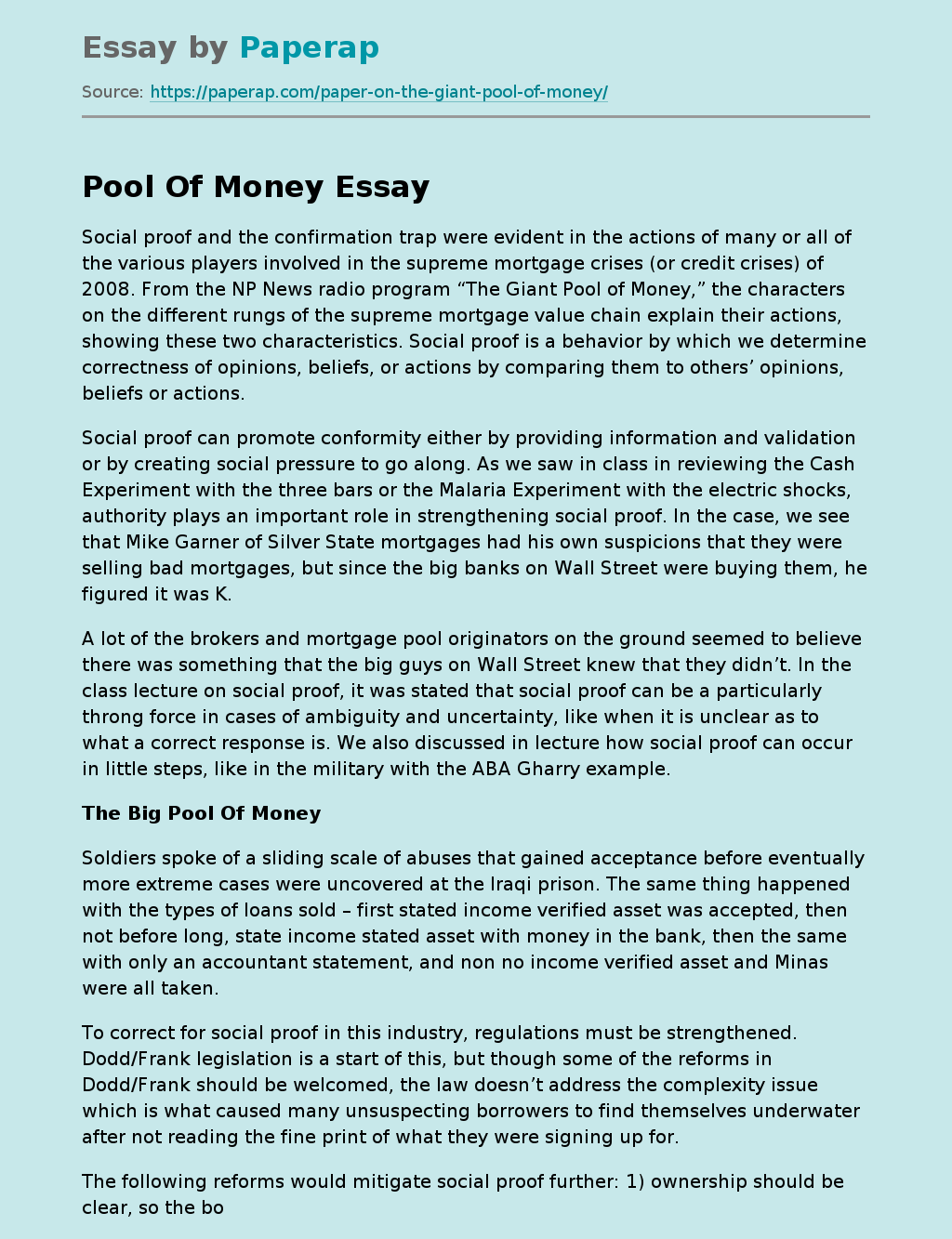Social Proof and the Mortgage Crisis
Social proof and the confirmation trap were evident in the actions of many or all of the various players involved in the supreme mortgage crises (or credit crises) of 2008. From the NP News radio program “The Giant Pool of Money,” the characters on the different rungs of the supreme mortgage value chain explain their actions, showing these two characteristics. Social proof is a behavior by which we determine correctness of opinions, beliefs, or actions by comparing them to others’ opinions, beliefs or actions.
Social proof can promote conformity either by providing information and validation or by creating social pressure to go along. As we saw in class in reviewing the Cash Experiment with the three bars or the Malaria Experiment with the electric shocks, authority plays an important role in strengthening social proof. In the case, we see that Mike Garner of Silver State mortgages had his own suspicions that they were selling bad mortgages, but since the big banks on Wall Street were buying them, he figured it was K.
A lot of the brokers and mortgage pool originators on the ground seemed to believe there was something that the big guys on Wall Street knew that they didn’t. In the class lecture on social proof, it was stated that social proof can be a particularly throng force in cases of ambiguity and uncertainty, like when it is unclear as to what a correct response is. We also discussed in lecture how social proof can occur in little steps, like in the military with the ABA Gharry example.
The Big Pool Of Money
Soldiers spoke of a sliding scale of abuses that gained acceptance before eventually more extreme cases were uncovered at the Iraqi prison. The same thing happened with the types of loans sold – first stated income verified asset was accepted, then not before long, state income stated asset with money in the bank, then the same with only an accountant statement, and non no income verified asset and Minas were all taken.
To correct for social proof in this industry, regulations must be strengthened. Dodd/Frank legislation is a start of this, but though some of the reforms in Dodd/Frank should be welcomed, the law doesn’t address the complexity issue which is what caused many unsuspecting borrowers to find themselves underwater after not reading the fine print of what they were signing up for.
The following reforms would mitigate social proof further: 1) ownership should be clear, so the borrower knows who owns his or her debt, 2) collateralized debt obligations should only be able to be sold by brokers who are educated on their risks by a government agency, 3) Minas and other non-verified mortgages should be outlawed and 4) Banks and mortgage originators should invest in shorting mortgage backed securities so there is some skin in the game for the financial institutions to not only grow fast, but loan smart money and benefit if others make risky decisions.
The confirmation trap (or confirmation bias) is the second behavior that emerged from the potash. The confirmation trap refers to the tendency for people to naturally seek information that confirms their expectations and hypothesis, even when discomforting or falsifying information is more useful. In the Carter Racing case, this was shown in how the chief mechanic showed that engine failures occurred at all different temperatures, but omitted that all the successes happened when temperatures were higher than 70 degrees.
In the case of “The Giant Pool of Money’, the financial world seemed content to ignore the warning signs that these pools of loans were, as one put it, ‘toxic waste. ” Rather, everyone up and down the value chain seemed content to seek out information that would confirm their biases and continue making them money. One piece of data (which turned out to be faulty) was their reliance on the credit rating agencies, which rated these pools of NINA loans as AAA, or as good as a truancy of solidly vetted mortgages.
Another piece of confirmation bias data was how Wall Street kept pointing to rising housing prices as evidence that this bubble would never burst, since poor borrowers could always take out a home equity line on their house powered by the revenue stream of the rising prices. They also justified their behavior by the fact that even if the homes foreclosed, they would remain valuable, due to the rising prices. These are all confirmation biases. Mike Garner said that when his boss raised Objections to the shady loans, he was rebuffed by others justifying the loans as an attempt to gain more market share.
The best way to fix the confirmation bias in this case would have been for the ratings agencies to offer more accurate data. Unfortunately, many of those working at ratings agencies would go on to work on Wall Street or vice versa, making their vested interest in shutting down a lucrative practice on Wall Street little to none. Government regulation is needed in order to ensure the ratings agencies remain independent and accountable to everyday citizens.
Another solution to the confirmation bias in the world of finance is through education. If financial education was made a bigger priority in schools, borrowers like Richard in Brooklyn might have known to ask better questions before taking an explosively bad loan on his East Flatfish house. When the information flow is coming from people with a vested interest in your investment decisions, confirmation bias will only flourish. Education can present both sides to the consumer and combat the use of confirmation bias.
Social Proof and the Mortgage Crisis. (2019, Dec 05). Retrieved from https://paperap.com/paper-on-the-giant-pool-of-money/

